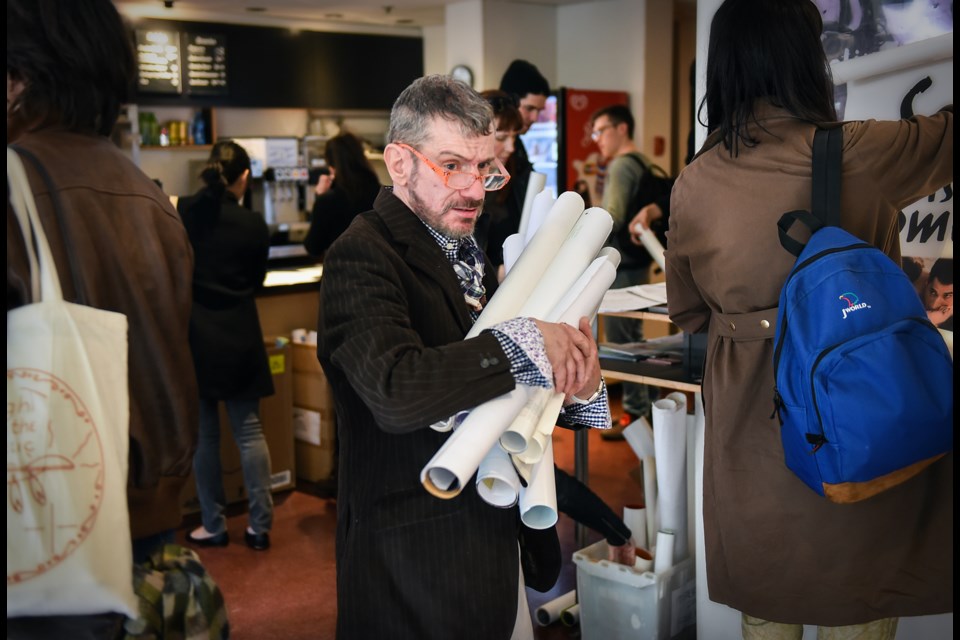Many people’s experience with posters didn’t follow them past their teen years when either Heather Locklear or her big-haired equal Rob Lowe adorned many a suburban bedroom wall.
But real poster collecting, just like any other subgroup of collectors, is about the hunt for both rare and favourite which is why the Cinematheque was score heaven Saturday morning.
The Cinematheque advertised its Poster Sale as an annual event but the truth is the last one was seven years ago. Since then, the theatre has amassed hundreds of arthouse posters that volunteers tirelessly cataloged for the first time for the sale where the most expensive boutique poster had a $25 price tag. This excluded the auction for three first-edition posters of blockbusters Raiders of the Lost Ark, Back to the Future and Return of the Jedi where the starting bid was also reasonable (money raised supports the theatre’s Indie Filmmakers Lab for kids).
“The posters definitely act as art but they’re also tokens or mementos of the experience. What I’m hoping for is the people coming in have a personal connection to the film that they saw here,” said the Cinematheque’s operations and marketing director Shaun Inouye minutes before doors opened to the dozens waiting outside the Vancouver cinema. “What’s also neat about this is that it’s a history of the programming at the Cinematheque as well.”
The handful of Cinematheque volunteers and staff who worked the two-hour long sale were happy to put the posters in the hands of appreciators rather than online auction opportunists. When Inouye scanned the line-up he said was pleased to recognize faces of several patrons.
Those in the line-up were given a sheet with the list of available titles and scampered into the small lobby to rummage through the boxes that contained finds such as Michelangelo Antonioni’s L’Avventura (1955), Jean Luc Godard’s Every Man For Himself (1980), and Roberto Rossellini’s Rome Open City (1945). Inouye picked up a Francois Truffaut poster while volunteer Alan Kollins said he already had 50 titles in his own collection, including his most cherished David Cronenbergs. But not all posters went to the homes of keen collectors — Reilley Pollard, one of the first through the door, bought Vittorio De Sica’s The Bicycle Thief and Federico Fellini’s 8 ½ because he just moved into a new place and wanted art for the walls.
Posters once travelled with the film canister from theatre to theatre (why first-editions are exceptionally rare, theatres had to return them, all folded up, along with the film) and the collector’s market didn’t start until the 1960s — notably when many European films were making their way to North America. The beauty of restoring arthouse films is that the distribution companies have virtual free reign when it comes to poster design, as they’re appealing to a niche audience.
“They get quite creative with the imagery and the artist they bring in to work on the posters because they’re distilling the film into a particular image,” said Inouye. “With blockbuster or mainstream films, they’re really selling the actors that are in it so that’s why you see that classic Photoshop look with all the main actors standing next to each other with probably nothing else about the film.”
The Cinematheque prides itself on giving Vancouverites a film education based on its programming. It was established as a film society in 1972 and, according to Inouye, is one of the most active film societies in Western Canada with more than 500 film screenings each year which includes international cinema, director retrospectives, contemporary Canadian films, arthouse classics, and experimental shorts.
And it’s the glimpses of appreciation that leave the people behind the curtains at the Cinematheque happy.
“I saw somebody find the poster for The Color Wheel and that was really neat because they remember seeing it here two years ago,” said Inouye, “There are titles a lot of people know but it’s those jewels — those films that didn’t break through to the mainstream at all — that people have a different relationship with. It’s almost like an ownership. They’re a fan and they like a film that not everybody does and The Color Wheel is definitely one of those films which is the best part about it.”
twitter.com/rebeccablissett



